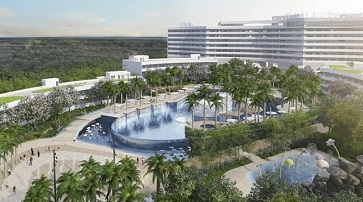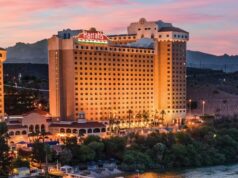
NATIONAL REPORT—Coastline hotels, resorts and other properties in areas prone to wind and flooding damage from storms can help themselves by implementing sustainable, resilient design techniques. So says Tom Hook, Principal and Director of Landscape and Planning for B+H North America. Hook recently spoke on the topic at the Caribbean State of Tourism Industry Conference. Caribbean tourism is especially vulnerable to hurricane destruction. In fact, the World Travel and Tourism Council predicts the Caribbean will become the most at-risk tourist destination in the world between 2025 and 2050.
Architects know how to design buildings to withstand strong hurricane winds but often fail to consider stormwater management and flood mitigation. Hook says that with proper landscaping and the right materials one can minimize the impact of a storm. Embedding resiliency in a project is the key. Allowing nature to do its work is also important.
To slow down the flow of stormwater Hook recommends avoiding hard surfaces and instead using permeable pavement, green roofs, and bioswales. Green roofs capture rainwater and slow down its flow. Permeable pavement allows water to percolate through it rather than over it. According to Wikipedia, bioswales are “landscape elements designed to concentrate or remove debris and pollution out of surface runoff water. They consist of a swaled drainage course with gently sloped sides (less than 6 percent) and filled with vegetation, compost and/or riprap (loose stone).”
The importance of properly locating a building and designing to mitigate the flow of water is critical at a time when climate change is making storms more intense. “The analysis is very important and where you locate buildings,” Hook says. “When it does rain, you want to know that the water is going to go where you want it to go.”
Promote Natural Drain Features
“If it is a new development, look at what is really happening on the site,” Hook adds. “You need to ask, ‘How do we create something that is resilient?’ You want to promote the natural drain features. Retention ponds can become an attractive part of a development. You can really change the impact of flooding and preserve beaches.”
Hook says building owners usually have many guidelines to follow for the interior of their buildings but very little for exterior areas. “There are no standards for drainage infrastructure,” he says.
Hook’s company is just beginning to implement the water mitigation strategies described above. “These systems are not that high-tech,” he says. “The land works for you. It is not any more expensive. People assume it will be more expensive.”
By taking steps such as those described above, the cost of construction can be reduced without dramatically impacting the look of a project. “We have done a number of these projects,” Hook says. “You don’t necessarily notice a difference. It becomes a feature that you don’t realize is a feature.”
One upside to designing with the environment in mind is that the project becomes a magnet for wildlife. “You will attract many different birds and animals,” Hook says.
Glenn Hasek can be reached at editor@greenlodgingnews.com.






